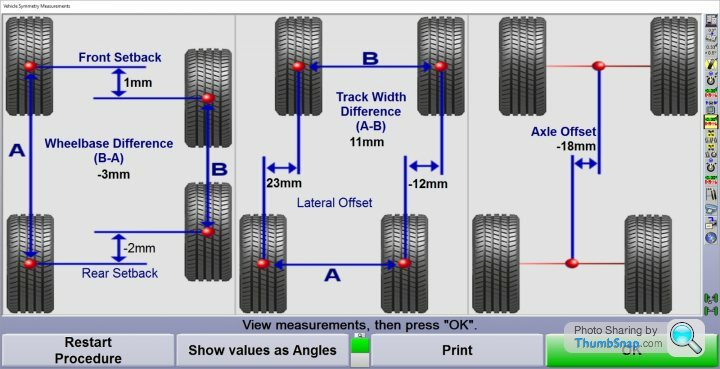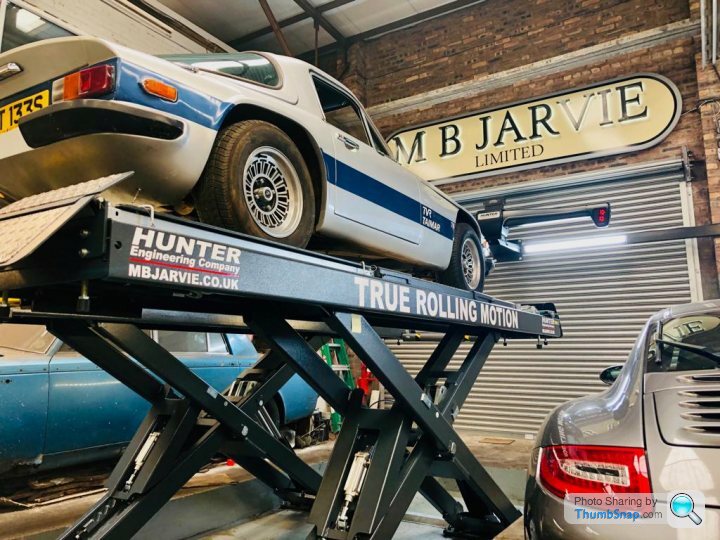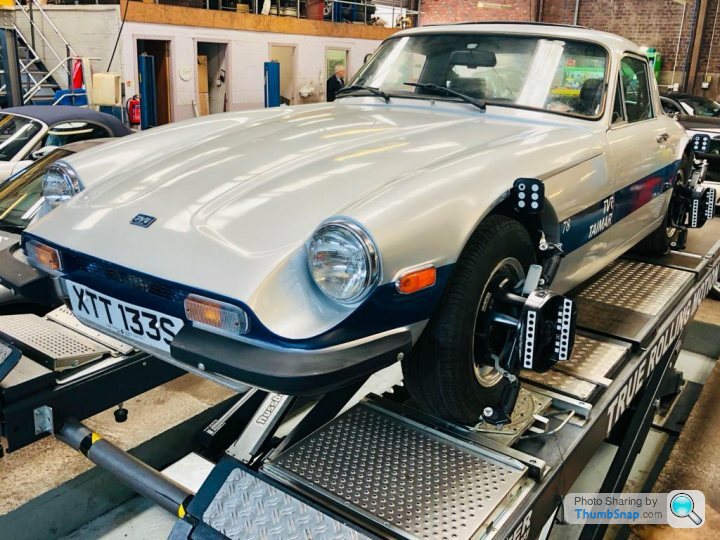Do M Series chassis come squarer than this?
Discussion
Evening all,
My Dad is about to begin the resto of a Taimar he has owned for nearly 40 years.
Unfortunately it was pranged about 15 years ago and was a touch and go write off. However, it was repaired on a budget and did eventually get an MOT. It has not seen a lot of action since for various reasons and is now in need of full restoration.
A friend of mine has a garage with a Hunter wheel alignment rig so we put Tiver on there to check she was square before we start pulling it apart. Getting data was tricky but we managed to extract some results including the following:

Clearly by modern standards the car is way out of tolerance, however by TVR manufacturing standards of the time is this actually fairly normal?
How easy is it to adjust out the axle offset which is the main area of concern?
Quick responses appreciated as the car is still up on the ramp awaiting a decision!
Many thanks
PS here she is:


My Dad is about to begin the resto of a Taimar he has owned for nearly 40 years.
Unfortunately it was pranged about 15 years ago and was a touch and go write off. However, it was repaired on a budget and did eventually get an MOT. It has not seen a lot of action since for various reasons and is now in need of full restoration.
A friend of mine has a garage with a Hunter wheel alignment rig so we put Tiver on there to check she was square before we start pulling it apart. Getting data was tricky but we managed to extract some results including the following:

Clearly by modern standards the car is way out of tolerance, however by TVR manufacturing standards of the time is this actually fairly normal?
How easy is it to adjust out the axle offset which is the main area of concern?
Quick responses appreciated as the car is still up on the ramp awaiting a decision!
Many thanks
PS here she is:


The trouble , as I see it, is, although you have lots of measurements you can’t from the way it’s measured establish what is actually out.
I would imagine, if as you say it was repaired on a budget, you have an accumulation of errors.
The chassis could be bent.
The wishbones might be bent.
The pick up brackets may be out of position .
On the upside I bet it goes around roundabouts well!
I would imagine, if as you say it was repaired on a budget, you have an accumulation of errors.
The chassis could be bent.
The wishbones might be bent.
The pick up brackets may be out of position .
On the upside I bet it goes around roundabouts well!
The best way to check the chassis is when it's been dismantled, with the chassis evenly supported on a level floor, you can drop plumb lines, and draw in and measure diagonals, to find out how square the chassis is, in sections and overall.
Then work out to the pickup points, and then onto wheel positions (to include wishbones etc). There are plenty of adjustments available, but if its not square to start with, then you will be rebuilding a compromised car! I'd start with a square chassis and work outwards, at least you'll be comfortable when its fully rebuilt!!!
Then work out to the pickup points, and then onto wheel positions (to include wishbones etc). There are plenty of adjustments available, but if its not square to start with, then you will be rebuilding a compromised car! I'd start with a square chassis and work outwards, at least you'll be comfortable when its fully rebuilt!!!
Little_Blue_Car said:
Evening all,
My Dad is about to begin the resto of a Taimar he has owned for nearly 40 years.
Unfortunately it was pranged about 15 years ago and was a touch and go write off. However, it was repaired on a budget and did eventually get an MOT. It has not seen a lot of action since for various reasons and is now in need of full restoration.
A friend of mine has a garage with a Hunter wheel alignment rig so we put Tiver on there to check she was square before we start pulling it apart. Getting data was tricky but we managed to extract some results including the following:

Clearly by modern standards the car is way out of tolerance, however by TVR manufacturing standards of the time is this actually fairly normal?
How easy is it to adjust out the axle offset which is the main area of concern?
Quick responses appreciated as the car is still up on the ramp awaiting a decision!
Many thanks
PS here she is:


Track width and Axle offset suggests a bent chassis. My Dad is about to begin the resto of a Taimar he has owned for nearly 40 years.
Unfortunately it was pranged about 15 years ago and was a touch and go write off. However, it was repaired on a budget and did eventually get an MOT. It has not seen a lot of action since for various reasons and is now in need of full restoration.
A friend of mine has a garage with a Hunter wheel alignment rig so we put Tiver on there to check she was square before we start pulling it apart. Getting data was tricky but we managed to extract some results including the following:

Clearly by modern standards the car is way out of tolerance, however by TVR manufacturing standards of the time is this actually fairly normal?
How easy is it to adjust out the axle offset which is the main area of concern?
Quick responses appreciated as the car is still up on the ramp awaiting a decision!
Many thanks
PS here she is:


Little_Blue_Car said:
Thanks for the feedback everyone - am I right to conclude from the comments that the 18mm offset is more than would be expected from the factory?
No one is actually going to know the answer to that question.But, having seen and done a little work with some of the original factory jigs I would expect an accuracy of at least +/- 5mm overall ( on any single fabricated part) was achievable by a trained monkey..
Edited by GAjon on Thursday 27th June 10:24
All these on-wheel tracking devices assume the average of all the measurements is on the centreline of the chassis, which isn't necessarily the case.
Consider a car with 12 inch wishbones one side, 6 inch the other side. The hunter may well say all the wheels are tracking ahead (because the only data it has is from the wheels, not the actual chassis) , but has absolutely no idea about the fundamental problem with the wishbone lengths.
I've seen so many old cars set up on laser aligners which are in fact not set up correctly at all. They may well be great for modern cars, but not for older stuff where production tolerances can cause accumulated errors.
Having said that your car seems a long way out .. now you need to find out why.
You need to get your plumb lines, string, measuring stick etc out and start plotting what you actually have on the car, then you can set about correcting it.
Or you can just leave it alone and set it up on the basis that close enough is close enough .. I doubt many drivers would actually notice anything wrong from an M driving experience point of view if you got most of it close (Ex M owner here!)
There's a culture around laser aligners and Hunters especially whereby if the machine says it's right then it must be right. It's sometimes not true.
I used to work at a garage that used to charge for Hunter alignment and corner weighting and it wasn't cheap.
The mechanics would hang off the corners of the car to make the pretty boxes go green and hit the print button. And there wasn't a flat piece of floor in the place to do corner weighting on. Not true of all garages, in fact not true of the vast majority, but you have to be mindful of the phrase "all the gear and no idea" ...
Consider a car with 12 inch wishbones one side, 6 inch the other side. The hunter may well say all the wheels are tracking ahead (because the only data it has is from the wheels, not the actual chassis) , but has absolutely no idea about the fundamental problem with the wishbone lengths.
I've seen so many old cars set up on laser aligners which are in fact not set up correctly at all. They may well be great for modern cars, but not for older stuff where production tolerances can cause accumulated errors.
Having said that your car seems a long way out .. now you need to find out why.
You need to get your plumb lines, string, measuring stick etc out and start plotting what you actually have on the car, then you can set about correcting it.
Or you can just leave it alone and set it up on the basis that close enough is close enough .. I doubt many drivers would actually notice anything wrong from an M driving experience point of view if you got most of it close (Ex M owner here!)
There's a culture around laser aligners and Hunters especially whereby if the machine says it's right then it must be right. It's sometimes not true.
I used to work at a garage that used to charge for Hunter alignment and corner weighting and it wasn't cheap.
The mechanics would hang off the corners of the car to make the pretty boxes go green and hit the print button. And there wasn't a flat piece of floor in the place to do corner weighting on. Not true of all garages, in fact not true of the vast majority, but you have to be mindful of the phrase "all the gear and no idea" ...
Gassing Station | TVR Classics | Top of Page | What's New | My Stuff




